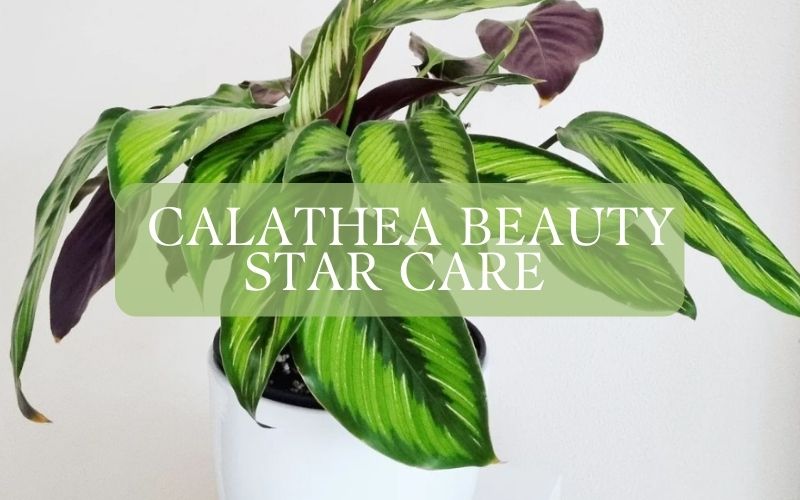Calatheas Beauty Star is an exotic variety of houseplants enchanting people with their vibrant, striped leaves and bold colors for many years. Their beauty is truly a delight! Native to South and Central America, this exotic-looking plant will add a distinctive flair to your home decor. But, like all tropical plants, they can be tricky to care for due to their higher needs in light, water, humidity, and temperature.
Fortunately, we’ve created your complete guide: Calathea Beauty Star Care. From watering tips to types of soil and much more, this comprehensive article will help ensure your plant stays alive and healthy while also making a lush statement in any living space. Let’s dive into the best way how to take optimum care of your Calathea Beauty Stars!
About Calathea Beauty Star
The herbaceous perennial Calathea ‘Beauty Star’ plant, also known as the Peacock Plant, Zebra Plant, and Prayer Plant, thrives in close proximity to a north or east-facing window as a houseplant.
Native to Brazil amid South America’s beautiful tropical forests are the calathea plants. Numerous nurseries and greenhouses offer Beauty star varieties for sale as indoor house plants all across the US and other non-tropical nations.
This Calathea is a cultivar of Calathea ornata, a sizable group of stripped Calatheas that are incredibly well-liked indoor plants due to their eye-catching leaf patterns. The marantaceae family includes the calathea “Beauty Star” plant. Their rectangular, green leaves have white and silver stripes, and they rise during the day and lower at night.
This Calathea is known as the “prayer plant” because, like other plants in the Marantaceae family, it has the unique habit of raising its leaves in the morning and lowering them at night, as if in prayer.
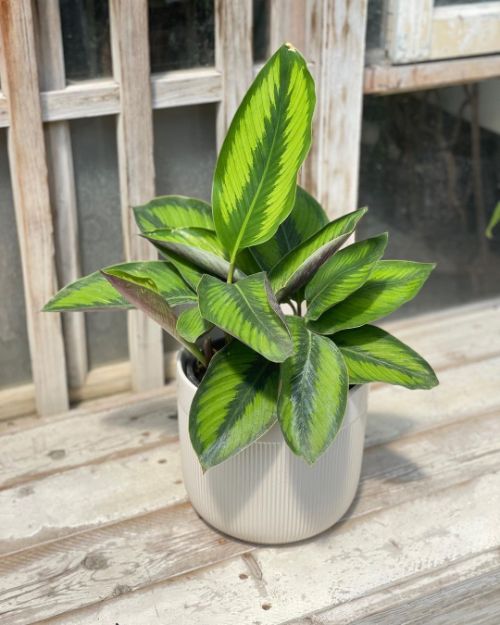
Calathea Beauty Star Care Quick Overview
| Botanical Name | Calathea Beauty Star |
| Scientific Name | Calathea ornata |
| Plant Family | Marantaceae |
| Origin | Brazil and South America |
| Plant Type | Herbaceous perennial |
| Max Growth (approx) | Up to 2 ft. (24 in.) tall and wide |
| Flower | blooms in summer |
| Light | Medium to bright filtered or indirect light |
| When To Water | Often after every 2 to 7 days during the growth period |
| Humidity | higher than 60% |
| Soil | well-draining soil, never soggy |
| Temperature | 65-85°F (18-29°C) |
| Flower | blooms in summer |
| Toxicity | Non – Toxic |
Calathea Beauty Star Care Tips
Watering
Watering your Calathea Beauty Star is an essential part of keeping it healthy and thriving. Water only when the top layer of soil feels dry to the touch, and always use filtered or distilled water if possible. Following these recommendations:
- Water until the excess flows out from the drainage holes in the bottom of the pot, then discard any remaining water that has accumulated in the drip tray.
- Water deeply but infrequently, and avoid overwatering as your Calathea Beauty Star may suffer from root rot if the soil is kept too wet.
- During the summer months, you may need to water more frequently, often after every 2 to 7 days, but always check the top layer of soil first to ensure it’s not already damp before adding more.
- You won’t need to water as frequently in the winter. Deeply, but less regularly, water your plants.
- Water your Calathea Beauty Star from the top of the soil and avoid direct contact with its delicate foliage.
- If you’re using tap water, I suggest keeping it out in a jar or watering can for 24 hours because the fluoride and other contaminants in the tap water are harmful to plants.
- Finally, mist occasionally to provide additional humidity for your plant.
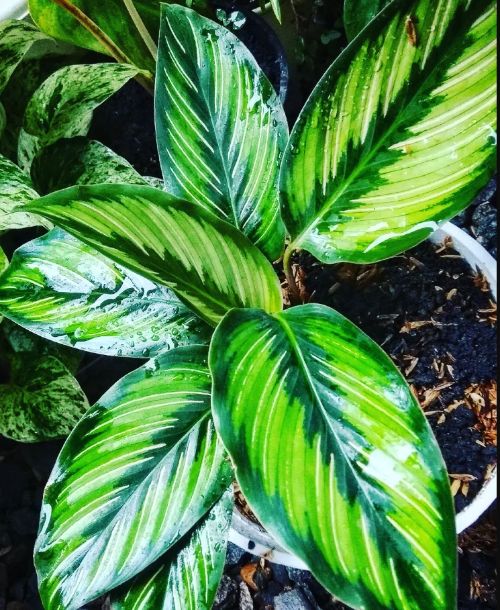
Ideal Humidity
The Calathea has extremely high humidity needs. It can tolerate 50% humidity, which is the lowest amount. The optimal circumstances you provide for the plant increase with increasing humidity.
High humidity promotes the plant’s growth, ease of survival, and health, which makes multiplication easier for the following year or two. It is best to keep humidity levels between 70%-90% for the Calathea Beauty Star in order to ensure its optimal growth.
It is important to note that humidity should be kept at a consistent level throughout, as sudden changes can cause shock and damage the plant’s delicate leaves.
If the humidity drops too low, you may need to use humidity trays or add a humidifier to the environment. Or by grouping your Calathea with other house plants that require similar circumstances, you can create a microclimate for it.
If the humidity is too high, you may need to look at ways of reducing humidity levels such as using fans and air conditioning units.
To prevent fungus and bugs that love damp, hot air, just make sure they are all healthy and have enough air circulation between them.
Tips: To ensure your Calathea Beauty Star thrives in its humidity requirements, it is important to regularly monitor humidity levels with a hygrometer, and take the necessary steps to adjust humidity levels accordingly.
Ideal light
Calathea Beauty Star plants thrive in indirect, bright light.
Ideal lighting for Calathea Beauty Stars is a few hours of morning sunlight or near the window that receives sufficient, indirect light throughout the day. The best exposure is to an eastern or northern window that receives bright yet filtered light.
You could try a few different locations in your house until you discover the one where your Calathea feels most comfortable. Use light curtains to moderate the light if you are forced to place your Calathea in a room with excessive light.
Make sure to avoid direct sunlight as it can scorch the leaves. With enough light, this plant exhibits its most beautiful foliage with purplish-green hues.
It is also recommended to rotate the plant occasionally so that it will receive light evenly throughout its foliage. Low light conditions can cause the leaves to become pale or turn yellow, which indicates that they are not getting enough light.
If the edges or brown spots on your Calathea’s leaves begin to appear, transfer the plant to an area with less light.
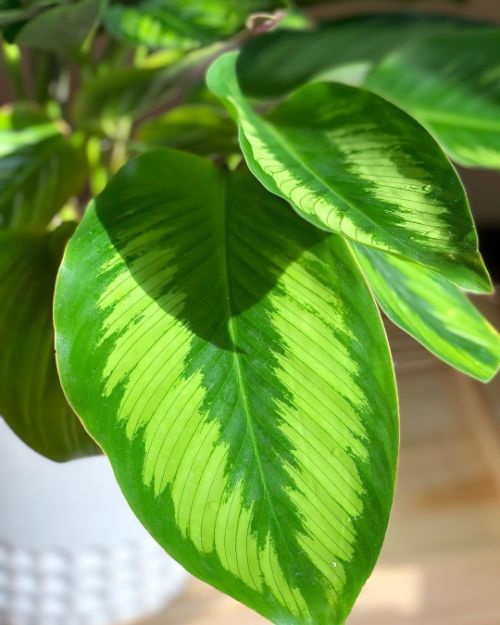
Required temperature
The ideal temperature range for Calathea Beauty Star should be between 65°F and 85°F (18-29°C).
Avoid temperatures lower than 65°F as this can cause the leaves of the plant to curl up, yellow, and become dry.
In colder environments, it is advisable to keep the plant away from drafts and radiators to ensure that it can maintain an optimum temperature for its growth. High temperatures should also be avoided as this will cause damage to the leaves of the plant.
If temperatures exceed 85°F, then it is important to manually adjust the humidity levels in order to keep the plant healthy.
With proper care and attention, Calathea Beauty Star can thrive in any home or office environment.
Soil
Soil is an must-have for the health and growth of Calathea Beauty Star plants. Soil should be light, well-draining, and have a neutral to slightly acidic pH level with an ideal pH of 6.5.
Soil should also contain organic matter like peat moss or compost that will provide nutrients and help retain moisture around the plant’s roots.
Use potting mixes specifically designed for houseplants or create your own blend mixing:
- one part loam
- one part peat moss
- one part perlite.
Soil should be kept slightly moist at all times. Soil can also be supplemented with a slow-release fertilizer to promote further growth and health of the plant.
Soil should be checked regularly to ensure it is not too dry or too wet. If the soil feels dry to the touch then it is time to water your plant. Too much water can cause root rot, so be careful not to overwater.
Fertilizer
Fertilizers are necessary for the proper growth and development of your Calathea Beauty Star, providing essential nutrients that are not found in regular potting soil.
You can use liquid fertilizer or organic fertilizers. Because they can aid in the plant’s faster growth, has no negative effects on the plant, and promote a healthy, nutrient-rich soil or potting mix.
To ensure your Calathea Beauty Star receives the right amount of nutrients, use a balanced fertilizer formulated specifically for Calathea plants.
Fertilizers should be applied every two to four weeks during the growing season, following the instructions found on your fertilizer packaging.
During the winter months, you can reduce fertilizing to once a month or even discontinue it altogether. The Calathea normally sleeps or goes dormant during these seasons.
Fertilizing too often can cause nutrient burn, which can significantly damage your Calathea Beauty Star. Remember to also flush the potting mix every few weeks to help prevent excess salts from building up.
Repotting
Repotting your Calathea Beauty Star is a simple process that should be done every 1-2 years to ensure optimal growth. Repotting is necessary when the plant has outgrown its current pot or when the soil has become compacted, preventing proper drainage and oxygen circulation for the roots.
- To start repotting, carefully remove the Beauty Star from its current pot.
- Gently loosen the roots and remove any excess soil or old potting mix.
- Next, choose a new pot that is only slightly larger than the previous one and has drainage holes.
- Fill the new pot with fresh, well-draining potting mix and gently transfer the plant, being careful not to damage the fragile roots.
- Water the soil to finish, and you’re done.
Make sure the new pot is slightly larger than the old one when repotting the plant. This will allow the roots enough time to once again outgrow the pot. Repotting should not be done in a pot with too much room, though. The plant won’t be encouraged to develop well in this way.
Repotting your Beauty Star not only keeps it healthy but can also help it reach its full potential in terms of size and beauty.
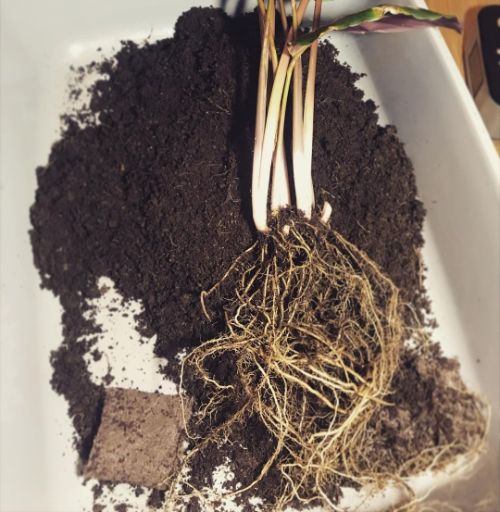
Pruning
Pruning can be an important part of caring for your Calathea Beauty Star. Pruning this type of houseplant helps to maintain its shape and encourages healthy growth.
- Prune your Calathea Beauty Star by removing any dead or damaged leaves and stems, and also remove any flower buds that may appear.
- Prune back the stems as needed to keep the shape of the plant full and bushy. Pruning your Calathea Beauty Star will help to keep it looking its best and encourage healthy growth.
- Prune regularly, as needed, to keep your Calathea Beauty Star looking its best. Pruning can also be used to control the size of your plant if it becomes too large for the space you have available.
- Pruning should be done carefully, as Calathea Beauty Star is a delicate plant and can get easily damaged if not pruned properly.
- Prune your Calathea Beauty Star in the early spring or summer months when new growth appears.
- Prune just above a leaf node (where a set of two leaves join together on the stem) to encourage branching and fuller growth.
- Prune sparingly, removing only small amounts of foliage at a time to keep the plant looking its best.
Tips: Older leaves may begin to wrinkle, become yellow, or turn brown. I advise you to prune those with sterile scissors or cutting shears, mostly for cosmetic reasons and safe for plants.
Calathea Beauty Star propagation
Calathea Beauty Star propagation is a relatively simple process and can be done with very little effort.
To propagate this plant, the easiest method is to the rhizome division:
- Remove your plant from its pot, gently brush off the soil, and pry the roots apart.
- Divide the mother plant into two or more plants by separating the rhizomes and leaves that are still linked.
- These root divisions are young Calathea plants, and each one needs its own container.
- Use the prepared soil mixture, and then thoroughly water it.
You must be patient, apparent growth may not appear for several weeks.
Another propagation of this plant is stem cuttings:
- Cut a 4-6 inch stem cutting from a healthy Calathea Beauty Star plant and place it in potting soil.
- Keep the soil moist and keep the plant in an area with bright, indirect light.
- The stem cutting should begin to root within four to six weeks.
- When the roots are two inches long, they can be transplanted into a pot containing fresh potting soil.
- Water regularly and fertilize monthly during the growing season for best results.
Propagating Calathea Beauty Star is a great way to share the beauty of this plant with friends and family. With patience and proper care, propagation can be successful.
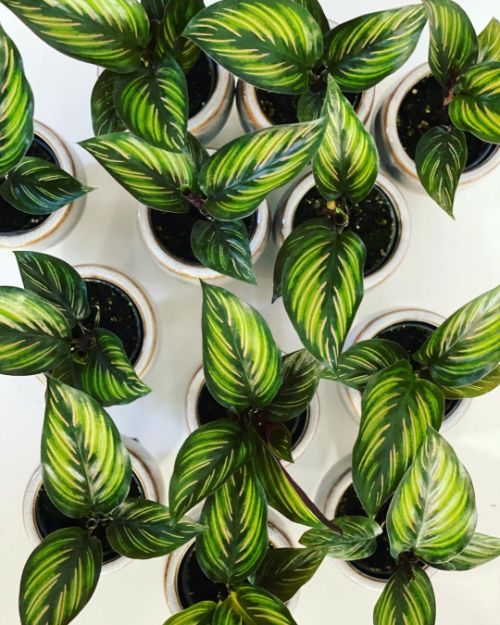
Calathea Beauty Star Care Common Pests & Common Problems
Common Pests
Calathea Beauty Star, like many indoor plants, is susceptible to pests that can harm the plant. Pests that commonly affect Calathea Beauty Star include:
- Spider mites: These tiny, spider-like creatures can cause leaf damage by feeding on plant sap. They are distinguished by the webbing they produce on the plant.
- Mealybugs: These white, cottony insects are frequently found on the undersides of the leaves and can cause the leaves to yellow or brown.
- Scale Insects: These small, brown insects can attach to the plant’s leaves and stems, causing yellowing, stunting, and premature leaf drop.
- Thrips: These tiny, slender insects can cause leaf damage by sucking the sap from the leaves, causing them to brown and wilt.
It is important to inspect your Calathea Beauty Star for signs of pest infestation on a regular basis to keep pests at bay. You can also keep your plant healthy by giving it enough water, light, and nutrients. If you find an infestation, try wiping the leaves with a damp cloth or using insecticidal soap or neem oil to treat it.
Common Problems
Common problems that may arise when growing a Calathea Beauty Star plant are overwatering, improper light exposure, and problems with leaves.
Overwatering
Overwatering can lead to root rot, as the soil will stay too wet for too long and prevent proper oxygenation of the roots.
Improper light exposure
Improper light exposure can cause stunted growth if not enough sunlight reaches the plant or foliage damage due to too much direct sunlight.
Problems with leaves
- Yellow leaves: If the leaves of your Calathea Beauty Star start to yellow, this may indicate that a nutrient deficiency is present and you should apply fertilizer accordingly. Following a regular fertilizing schedule and proper care to ensure healthy growth.
- Leaves Browned on Edges: If you notice curled leaves with brown edges and tips, you should suspect underwatering or excessive light. Your plant needs plenty of water, so give it some shade so it can recover. Once the leaves have recovered, leave them in a location with bright, indirect light.
- Calathea Beauty Star Drooping: Can also be brought on by infections, root rot, and over watering. Treatment of the underlying problem is the best course of action.
In an extreme case of dehydration, calathea beauty stars’ leaves will fall off. The leaves will initially curl, then crisp up before falling off. - Calathea Beauty Star Leaf Curling: Insufficient soil moisture can cause Calathea Beauty Star leaf curling. Once the top inch of soil is dry, make sure to water. Additionally, bad water quality to the curled leaves have a yellowish hue, browned edges, and burnt surfaces.
FAQ About Calathea Beauty Star Care
Q: What kind of soil should I use for Calathea Beauty Star?
A: Calathea “Beauty Star” prefers soil that is moisture retentive but well-draining. A good mix would include equal parts potting soil, peat moss, and perlite. Alternatively, you can use a ready-made potting mix intended for houseplants.
Q: Can I use artificial lights for my Calathea Beauty Star?
A: Yes, you can use a lamp with artificial lights if there isn’t enough light and you can keep your Calathea on your desk or in your living area.
Q: How often do I need to water my Calathea Beauty Star?
A: Water it only when the top inch of soil has dried out and often after every 2 to 7 days during the growth period. Make sure to avoid overwatering; too much moisture can cause root rot and other issues.
Q: How much sunlight does Calathea Beauty Star need?
A: Indirect light, but not too much direct sunlight. If your plant is placed in too much direct sunlight, its leaves may start to fade and burn. Place your Calathea “Beauty Star” in a spot that receives bright, indirect light, such as near an east-facing window. You can also supplement natural light with artificial grow lights if necessary.
Caring for a Calathea Beauty Star is rewarding, but it takes time and attention to detail. Its growth and overall health are dependent on providing the proper environment, such as a humid and warm location away from direct sunlight. Watering, fertilizing, and pest control must be done on a regular basis for it to grow properly. It’s important to keep an eye on the plant and look for signs of pests or diseases on a regular basis. The Calathea Beauty Star, with proper care, can be a stunning addition to any indoor plant collection.
By following the guidelines of FamiPlants, you’ll be well on your way to having a healthy and beautiful Calathea Beauty Star of your own.

